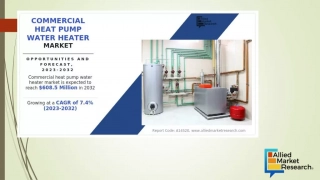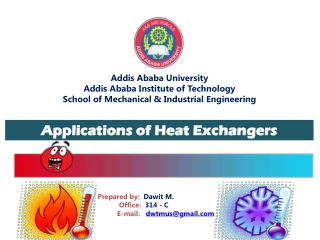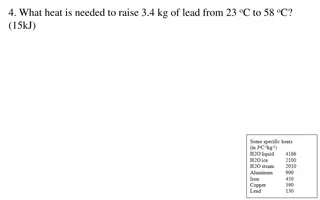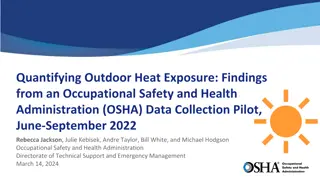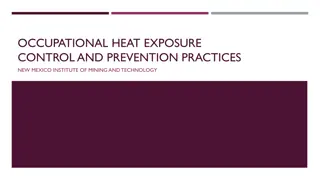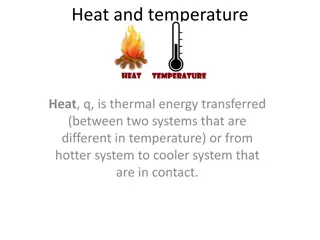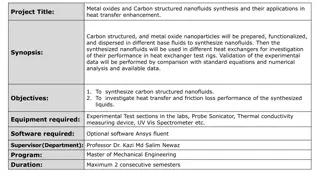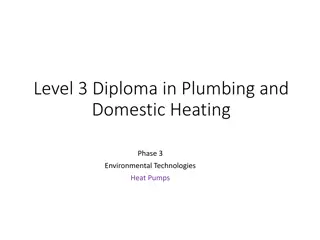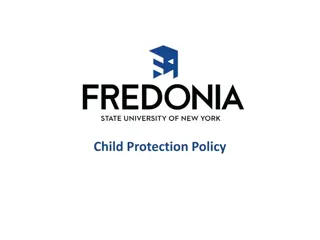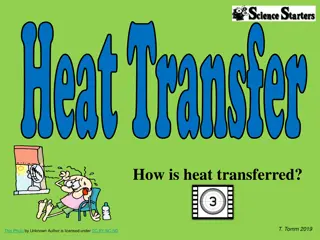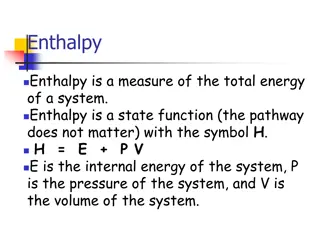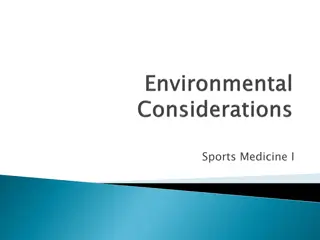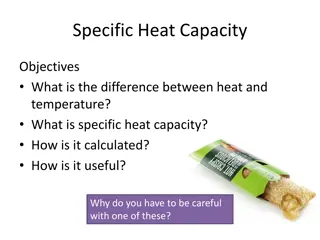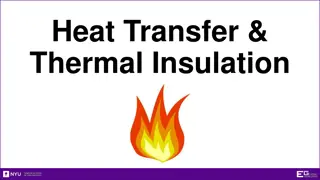
More Heat Than Light: The Use and Abuse of Thermodynamic Ideas
This article delves into the historical development of thermodynamic laws, the UK's energy use for heat, and the concepts of energy and exergy beyond traditional engineering applications. It critiques the misuse of thermodynamic ideas and explores the evolution of these laws in industrial innovation, emphasizing the impact on energy systems and environmental sustainability.
Download Presentation

Please find below an Image/Link to download the presentation.
The content on the website is provided AS IS for your information and personal use only. It may not be sold, licensed, or shared on other websites without obtaining consent from the author. If you encounter any issues during the download, it is possible that the publisher has removed the file from their server.
You are allowed to download the files provided on this website for personal or commercial use, subject to the condition that they are used lawfully. All files are the property of their respective owners.
The content on the website is provided AS IS for your information and personal use only. It may not be sold, licensed, or shared on other websites without obtaining consent from the author.
E N D
Presentation Transcript
Title More Heat Than Light : The Use and Abuse of Thermodynamic Ideas Geoffrey P. Hammond Department of Mechanical Engineering, University of Bath, Bath. BA2 7AY. [Email: G.P.Hammond@bath.ac.uk] International Exergy Economics Workshop, University of Sussex, Brighton, UK, 14-15 July 2016.
Contents Historical Development of the Laws of Thermodynamics UK Energy Use for Heat Thermodynamic Concepts and Tools: Energy and Exergy Beyond Engineering/Physical Thermodynamics, e.g., Environmental Sustainability Critique of the Misuse of Thermodynamic Ideas
Evolution of the Laws of Thermodynamics Industrial innovation does not necessarily imply a linear process - better scientific knowledge inevitably leading to new technological discoveries. The reverse process took place, for example, with James Watt's steam engine; its development preceded the understanding of what became known as the Laws of Thermodynamics . Modern derivatives of heat engines and power cycles are now widely recognised as having both positive and negative effects. They are at the heart of our energy supply and vehicle transportation systems, but also pollute the environment for humans and wildlife.
UK Energy Use for Heat Source: Institution of Civil Engineers, Heat, 2014.
Exergy Exergy is the available energy for conversion from a donating source (or reservoir) with reference to a specified datum; usually the ambient environment (T0) It is formally defined by : ( ) ( = S T H H E 0 0 ) ( ) + S N i i i i 0 0 The truncated form, known as the physical or thermo-mechanical exergy, is given by: ( H E = ) ( ) H T S S 0 0 0 Energy (First Law) analysis concerns the quantity of energy consumed in the production of a product or activity Exergy (First and Second Law) analysis concerns the quality of energy consumed in the production of a product or activity
Exergy in Practice E I out E = 1 1 The exergy efficiency E in in The exergetic improvement potential [after van Gool (1997)] ( )( E IP 1 ) E in out E Thermodynamic quality of an energy carrier H = Thus, for electricity : 1 T0 = 1 and for process heat : T p
Thermodynamic Quality Diagram Source: Hammond, Int. J. Energy Research, 2004.
Thermodynamic Concepts and Tools FIRST AND SECOND LAW CONCEPTS ENERGY QUANTITY EXERGY QUALITY IDENTIFYING PROCESS IMPROVEMENT POTENTIAL ENERGY ANALYSIS: CONSERVATION EXERGY ANALYSIS: ENERGY (OR HEAT) CASCADING It identifies scope for improvement potential; 80% in just three sectors of the UK economy - power generation, space heating in buildings and transport (Hammond & Stapleton, 2001). A Cautionary Note: Exergy analysis should not be elevated to a pivotal position.
Block Diagram of a 22MW Industrial CHP Plant STACK LOSS HEAT CONDENSATE RETURN EXTRACTED STEAM HEAT RECOVERY GENERATOR FUEL TURBINE POWER STEAM AIR GENERATOR COMBUSTION CHAMBER COMPRESSOR TO CONDENSER TURBINE POWER GENERATOR Source: Hammond, Int. J. Energy Research, 2004 (adapted from Bilgen, Energy, 2000).
Energy and Exergy Efficiencies of CHP Plant 80 100 80 22 MW INDUSTRIAL CHP PLANT Thermodynamic Efficiencies (%) 70 Steam Extracted (%) 60 60 ENERGY ( ) 40 50 20 EXERGY ( ) 40 0 1 2 4 6 10 20 Power-to-Heat Ratio Source: Hammond, Int. J. Energy Research, 2004 (adapted from Bilgen, Energy, 2000).
Energy and Exergy Efficiencies % 100 90 80 70 60 50 40 30 20 10 0 Fuel Fuel Fuel Fuel Fuel Fuel Electricity Electricity Electricity Electricity Electricity Electricity Low Temperature High Temperature Low Temperature High Temperature Mechanical Drives Mechanical Drives Energy Efficiencies Exergy Efficiencies Source: Hammond & Stapleton, Proc. IMeche Part A - JPE, 2001.
Co-opting Thermodynamics in the Ecological Domain Ecological economics sustainability and intergenerational ethics; the duty of every generation to maintain the stock of natural capital Entropy and irreversibility [after Georgescu-Roegen and others] Insights from thermodynamics indicates physical limits highlights the shortcomings of neoclassical economics The role of analogy and metaphor [after Hammond, 2004; S llner, 1997]
Energy and Material Flows Through the Earth s Biosphere The Earth s Biosphere Solar Energy Waste Assimilation Natural Resources Degraded Energy The Energy Economic System Materials Degraded Materials Recycled Materials Low Grade Thermal Energy Source: Hammond & Winnett, Sustainability, 2009 (adapted from Cleveland & Ruth, Ecological Economics, 1997).
The Ideas of Georgescu-Roegen The throughput of the economic sub-system is viewed as an entropic flow ; subject to the physical constraints. The Entropy Law as the taproot of economic scarcity: economic systems are ones in which energy (and matter) are conserved, whilst entropy increases. Led to a debate over the appropriate choice of thermodynamic properties: entropy, exergy or Gibbs free energy Matter Matters Too : A Fourth Law of Thermodynamics? Georgescu-Roegen asserted that matter undergoes irreversible processes similar to energy This is both dubious physics and economics: gradient diffusion versus materials recycling Source: Hammond & Winnett, Sustainability, 2009.
Critique of the Misuse of Thermodynamic Ideas - 1 Exergy is a more easily understood thermodynamic property than entropy to represent irreversibilities in complex systems. Energy and exergy analysis need to be performed in parallel in order to accurately reflect the interrelated constraints imposed by the First and Second Laws. The behaviour of energy and matter are not equally mirrored by thermodynamic laws. Source: Hammond & Winnett, Sustainability, 2009.
Critique of the Misuse of Thermodynamic Ideas - 2 Thermodynamic insights for the economic process and natural resource scarcity are simply analogues or metaphors of reality. Such insights should therefore be empirically tested against the real world. It may therefore be argued that perhaps a new vocabulary is needed for ecological economics: one that evolves a unique terminology, rather than co-opting that of engineering/physical thermodynamics. Source: Hammond & Winnett, Sustainability, 2009.
Concluding Remarks Exergy is a more easily understood thermodynamic property than entropy to represent irreversibilities in complex systems. Exergy reflects the ability to undertake work; particularly the use of electricity within an energy system or across the economy. Exergy does not represent well heating processes within an energy system or across the economy. Heat has a variable thermodynamic quality depending on the ratio of the process temperature to the environmental temperature or datum. Energy and exergy analysis should to be performed in parallel in order to accurately reflect the interrelated constraints imposed by the First and Second Laws.

